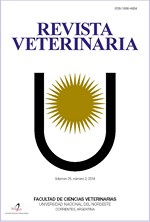Utilization of stent in canine tracheal collapse
DOI:
https://doi.org/10.30972/vet.3114629Keywords:
Dog, tracheal collapse, stent, endoprosthesis, breathing improvementAbstract
Tracheal collapse occurs mainly in small breed dogs, with ages ranging 5-9 years old. Symptoms may include breathing difficulty, chronic dry cough, rales, dyspnea, cyanosis and syncope. Surgical treatment is indicated in patients that do not respond to medication and have an advanced degree of tracheal collapse (reduction of tracheal lumen of 50% or more) and when collapse occurs in the intra-thoracic portion of the organ. Less invasive surgical techniques are preferred for high-risk patients, consisting in the placement of a self-expanding stent in the tracheal lumen. In a 14-year-old Shitzu dog, weighing 9 kg, with grade 5 tracheal collapse, video-endoscopy and digitalized radiographs were performed to determine the length and diameter of the appropriate stent. A self-expanding platinol stent, 10 mm in diameter and 100 mm in length, was used. After surgery, recovery was quick, and the endotracheal tube could be removed after 5 minutes without difficulties. Respiratory improvement after surgery was immediate and without complications.
Downloads
References
Brockman DJ, Holt DE. 2012. Manual de cirugía de cabeza, cuello y tórax en pequeños animales, Ed. Lexus, Buenos Aires, p. 157-171.
Faunt K et al. 2018. Anestesia y analgesia, Ed. Intermédica, Buenos Aires, p. 254-259.
Moy BT, Birk JW. 2015. Una actualización de los stents hepatobiliares. J Clin Transl Hepatol 3: 67-77.
Pinedo JA et al. 2008. Stents traqueo-bronquiales. Una revisión. Medigraphic Artemisa en línea 67: 117-141.
Rodríguez GJ, Martínez MJ, Graus MJ. 2012. Cirugía en la clínica de pequeños animales, Ed. Servet, Zaragoza, p. 238-255.
Slatter D. 2006. Tratado de cirugía en pequeños animales, 3ra. ed., Ed Intermédica, Buenos Aires, p. 1005-1031.
Downloads
Published
How to Cite
Issue
Section
License
Copyright (c) 2020 M. L. López, E. D. Saravia, M. B. Lockett

This work is licensed under a Creative Commons Attribution-NonCommercial 4.0 International License.
Revista Veterinaria (Rev. Vet.) maintains a commitment to the policies of Open Access to scientific information, as it considers that both scientific publications as well as research investigations funded by public resources should circulate freely without restrictions. Revista Veterinaria (Rev. Vet.) ratifies the Open Access model in which scientific publications are made freely available at no cost online.











.jpg)
.jpg)



